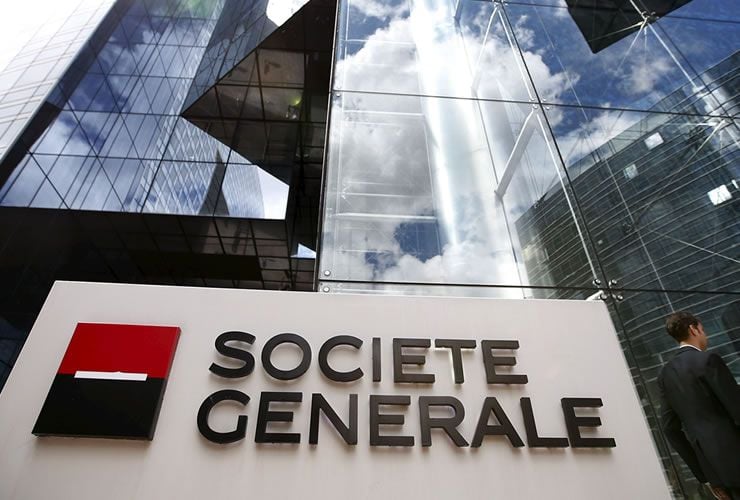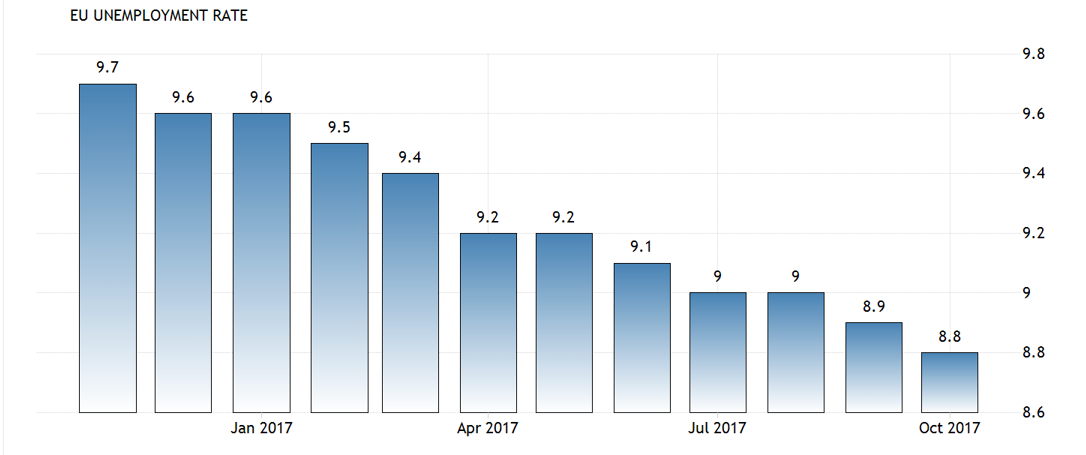Pound to Fall to Within Inches of Parity vs. the Euro say Sterling Bears Soc Gen

Pound Sterling is forecast to suffer a substantial decline against the Euro in 2018 by currency analysts at Société Générale who forecast the Pound-to-Euro exchange rate to almost hit parity.
Such a decline would leave the retail exchange rate on GBP/EUR available to international traders, expats and holiday-makers languishing well below 1.0.
The call made by Société Générale in their year-ahead forecasts makes them the holders of the most bearish forecast for this pair after Morgan Stanley last month retreated from their forecast which saw the Pound-to-Euro exchange rate falling to below parity in the first half of 2018.
Société Générale's forecast is based partly on the Euro strengthening after a long period of undervaluation, but also because the UK economy is set for a protracted period of stagnant growth, with Sterling following suit.
The Euro is now seen as being well below its long-term average (1.29 for EUR/USD) and below its theoretical fair-value based on Purchasing Power Parity (PPP) and an inevitable rise back to fair-value is envisaged.
Purchasing Power Recovery
PPP is the exchange rate arrived at by comparing the cost of a common basket of goods using the two currencies.
If a shopping basket in the UK costs 10.00 Pounds, and an identical basket in the Eurozone cost 10.50 Euros, then the PPP valuation for EUR/GBP would be 10 divided by 10.50, which is roughly 0.9523.
Given the actual current market rate is lower, at 0.8835, it could be argued that the Euro is undervalued and there is a chance it will rise back to fair-value at some point.
"For the eurozone, ‘normal’ means a strong(er) currency. The Euro is cheaper than the Yen on PPP, though not on some other measures. Over the past decade, EUR/USD has averaged 1.29, the same (to two decimal places, anyway) as the OECD’s average measure of purchasing power parity over that period," says analyst Kit Juckes at Société Générale's London office.
Driving the Euro back to fair-value against the Dollar and Pound is the region's ongoing economic expansion. The Eurozone region continues to grow at a steady clip while the unemployment rate is also seen declining:

The growing economy and falling unemployment are likely to allow the the European Central Bank (ECB) to pursue the kind of policies which would offer the Euro support.
The ECB is currently winding down its stimulus programme which was introduced to help support the financial system during the sovereign debt crisis.
This programme which includes record-low interest rates and money printing under the quantitative easing programme has had a weakening effect on the Euro, pushing it to well below fair-value. As the ECB slowly removes it and starts to 'normalize' policy, the Euro is expected to rise.
Get up to 5% more foreign exchange by using a specialist provider by getting closer to the real market rate and avoid the gaping spreads charged by your bank for international payments. Learn more here.
Sterling: A Decade of Stagnant Growth
Turning to Sterling, rather than predicting a steady growth curve for the U.K. economy, Société Générale see economic growth stagnating over coming months and years.
The expectations are in line with the independent Office For Budgetary Responsibility (OBR) which in November revised down growth forecasts for the next five years at the Autumn budget, and from averaging about 1.9% growth per year, they now think it is only likely to average 1.4%.
"The case for the UK economy to perform relatively poorly in 2017-27 seems pretty clear," says Juckes, who cites the low level of productivity in the economy as a driving factor for the lack of growth.
"If productivity growth doesn’t recover significantly from the 0.5% per annum of the past five years, even the downbeat economic projections that we saw recently from the OBR, looking for average GDP growth of 1.4% over the next five years (based on average productivity growth of 0.8% per annum) would be overly optimistic," adds the analyst.
Productivity is identified as problematic for the UK economy.
It is defined as the amount of work a single worker can get done over a given period of time.
To illustrate by example, a field of wheat can either be harvested by the farmer and 49 labourers in a day or by the farmer on his own driving a combine harvester in a day.
Using the combine harvester improves productivity 50-fold.
It is not necessarily about honest hard work - productivity is also about efficiency, skill, and technology.
The problem, economists argue, with the UK is that the existence of a large pool of cheap labour (aided perhaps by high immigration) has had a detrimental effect on productivity by making it more cost-effective for employers to employ cheap labour (the 49 farm workers) than to invest in technology or training (the combine harvester).
This of course means the wage paid to the 49 workers is far lower than a worker controlling a combine harvester; higher pay packets in turn drive up overall wealth and drive economic activity which is in turn supportive of the Pound.
So the UK is going to grow at a below-par rate for the next 10-years and this will weigh on the Pound.
Another pressure on the Pound, according to SocGen is that the UK's strong service export sector could be disproportionately hit by Brexit.
Like it or not, the jewel in the British economy's crown is the City of London, which is the biggest financial centre in the world, and the city has a thriving service export sector, however, if EU 'passporting rights' which allow financial services free reign to sell their services in the EU are revoked, the UK could be in danger of losing its 'jewel', further depressing growth, and the Pound.
"If the UK’s ‘new normal’ is a trend growth rate that is below 1.5% per annum, and if exports, particularly of services, are hampered by Brexit (a reasonable view), then the post-Brexit average level of sterling, at least in real terms, may not be much above current levels," says Juckes.
Forecasts for the Pound
Société Générale see the two currencies embarking on divergent trajectories in 2018, and if this materialises, they forecast the Euro-to-Pound exchange rate to rise to 0.94 by mid-2018, which gives a Pound-to-Euro exchange rate of 1.06.
EUR/GBP is seen at 0.98 by the end of 2018, giving a GBP/EUR exchange rate at 1.02.
Sterling's outlook against the Dollar are however a little more constructive, "even with Sterling making new lows in tradeweighted terms (nominal and real), we see the GBP/USD meandering in a 1.30-1.35 range for most of 2018," says Juckes.
Get up to 5% more foreign exchange by using a specialist provider by getting closer to the real market rate and avoid the gaping spreads charged by your bank for international payments. Learn more here.
Irish Border Angst
Sterling was seen trading between gains and losses versus the Pound and Dollar on Thursday, December 7 amidst ongoing uncertainty as to how the issue of the Irish land border would be dealt with when Brexit takes place.
This week saw Prime Minister Theresa May forced to abandon an announcement that “sufficient progress” has been made; something that disappointed Sterling bulls who had been anticipating an extension of recent strength on signs of progress.
Markets were hoping May would agree the wording of an agreement on how to avoid physical infrastructure at the Northern Irish border; one of the three hurdles that Brussels negotiators say must be met in order for talks to move on to the subject of future trade and transition.
For talks to progress, there needs to be a unanimous decision in favour of moving on, at the European Council summit on December 14 and 15. With the date drawing closer and an agreement yet to be reached, the risk of “no deal” in December is growing.
“We have long had a relatively bullish GBP view based on our expectation that the UK government would fold on all key issues in order to tie up a transition agreement well before the end of Q1 2018,” says Shahab Jalinoos, a strategist at Credit Suisse.
The government’s confidence and supply partner, the Democratic Unionist Party, objected to the wording of Monday’s agreement concerning the Irish border, saying it would lead to Northern Ireland being treated differently to the United Kingdom.
They have since shown no desire to hasten a decision on subsequent ammendments to the document, indeed, according to press reports the DUP are saying progress on the matter this week is unlikely. This is a problem as the European Union has said a deal must be agreed by the weekend for leaders to give the go-ahead on transission agreement talks at their mid-December conference.
The timing of the DUP’s objection was reported to have been the result of the agreement having been held back from the DUP, whose leaders are said to have seen it in the press first.
“We suspect we will be proven right on the financial aspects of the UK's offer to the EU necessary to win a transition deal, but clearly the picture is very cloudy with the issue of the Irish border problem,” says Jalinoos.
The Credit Suisse team say it “seems an impossible task” to have the UK leave the customs union and maintain an open border with the Republic of Ireland without having some other kind of border between the UK and the island of Ireland.




